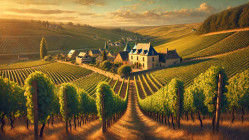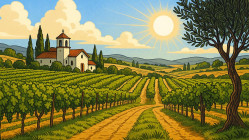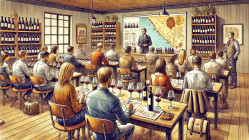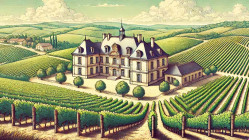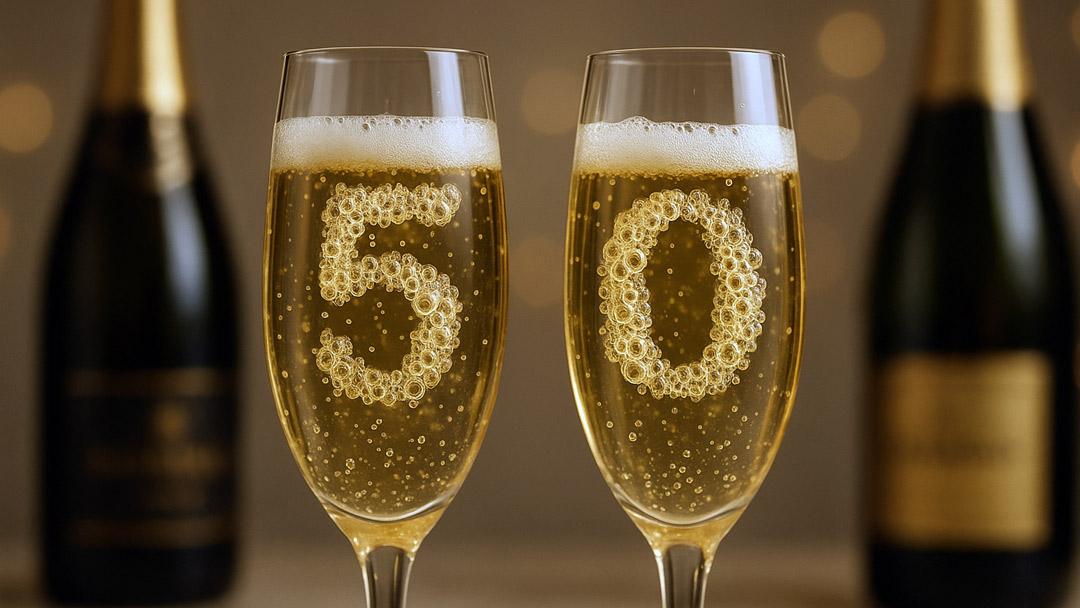
50 Producers That Shape the Champagne Region
Champagne is different. Nowhere else blends place, people and patience in quite the same way. The region sits on deep chalk that stores water and reflects light, which helps grapes ripen slowly in a cool climate. Still wines taste taut and sharp at first, so winemakers lean on a second fermentation in bottle, long ageing on lees, and careful blending to turn that raw energy into fine texture and length. Time is not a garnish here; it is an ingredient.
Two broad worlds sit side by side. The grandes marques, often called houses, buy fruit from many villages and keep large libraries of reserve wines. Their job is to be recognisable. A bottle of a house’s non-vintage should feel like the last one you loved, even if the harvest changed. Growers tend to focus on their own vineyards and bottle specific parcels or villages. Their job is to be particular. A single site, a single year, perhaps a single grape, with the edges left in place so the place can speak. Both approaches can be brilliant. Both can age.
Not all Champagne tastes the same. Chardonnay brings citrus, almond and chalk. Pinot Noir adds red fruit, spice, and structure. Meunier gives width and comfort. Dosage, the touch of sweetness added at disgorgement, can tilt a wine from brisk to generous. Oak can add breadth. Malolactic fermentation can soften a hard line or be avoided to keep a wine racy. Multi-vintage blends trade on consistency and depth. Vintage Champagnes tell a year’s story and often need time to settle. Single-vineyard and lieu-dit bottlings can feel like a lens, tight and focused.
Ageing potential varies widely. Some non-vintage wines are at their best within a couple of years. Many vintage and prestige cuvées evolve for a decade or more, swapping citrus and chalk for brioche, honey, and truffle. If you collect, think beyond names. Provenance, storage, and disgorgement dates matter. Liquidity differs. Global brands tend to move easily on the secondary market. Scarce grower wines can be harder to find, but are prized by collectors and investors.
This list brings together 50 important producers across houses and growers. The order follows the producer whose wines first appear in Wine-Searcher’s list of the world’s most popular wines, then continues through the rest of the names. Use it as a map. Read the snapshot for each producer, then scan the cuvées so you can tell the ranges apart at a glance. Champagne rewards curiosity, and there is plenty here to explore.
Dom Pérignon
Moët & Chandon’s prestige label Dom Pérignon is built on a simple rule: only vintage.
Fruit comes mainly from grand cru sites with Chardonnay and Pinot Noir in near equal measure, then ages for years to knit precision and breadth. Plénitude releases mark later waves of maturity, moving from citrus and stone to truffle, toast, and richness.
Rosé has a more vinous feel with real depth. On the market, back vintages with strong critic consensus tend to draw steady demand, and well stored bottles from benchmark years often track a clear secondary curve without the wild swings seen in rarities.
Cuvées
- Dom Pérignon (Vintage)
- Dom Pérignon Rosé (Vintage)
- Dom Pérignon P2 (Plénitude) (Vintage)
- Dom Pérignon P3 (Plénitude) (Vintage)
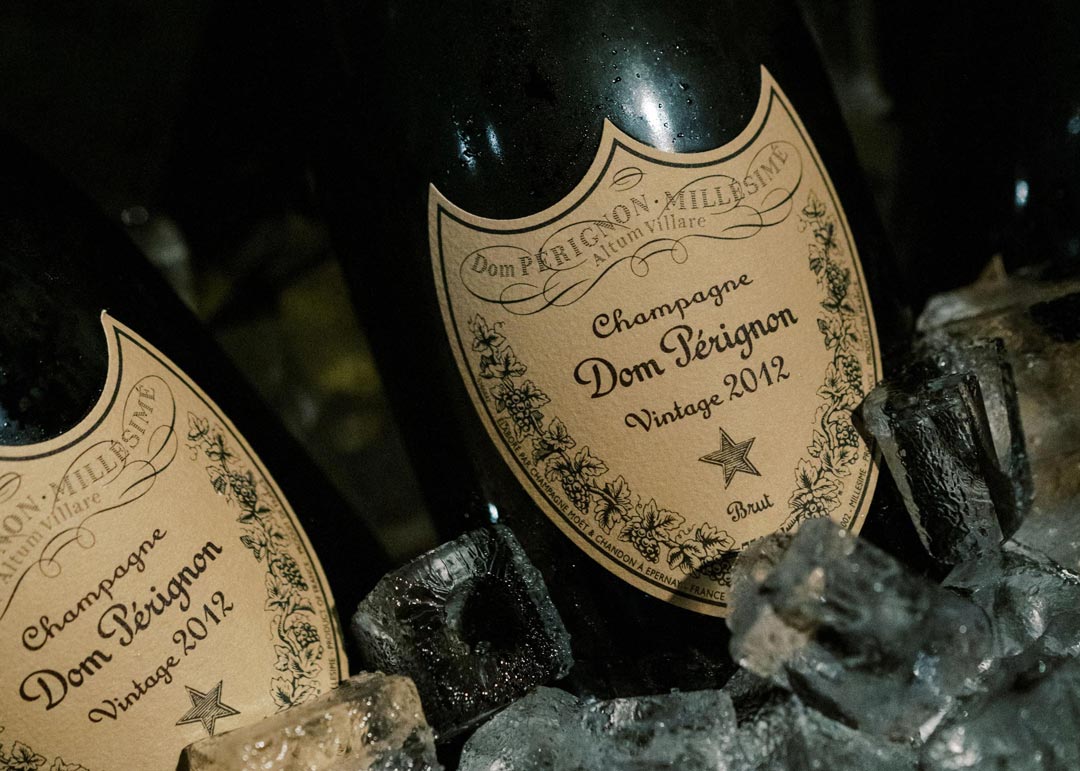
Image courtesy of Dom Pérignon.
Louis Roederer
Family-owned and vineyard-led, Louis Roederer has pushed hard on farming, with large tracts under organic or biodynamic practice. The shift from Brut Premier to Collection formalised a deeper focus on reserve wine libraries and parcels.
Cristal, created for Tsar Alexander II, is a reference for clarity and chalk tension in both white and rosé. Brut Nature with Philippe Starck showcases a sleeker, zero-dosage style.
From an investment view, Cristal releases are widely followed and liquid on the secondary market, while Collection has become a smart restaurant buy that quietly raises the base quality across the range.
Cuvées
- Collection (NV/MV)
- Vintage Brut (Vintage)
- Vintage Rosé (Vintage)
- Brut Nature (Starck) (Vintage)
- Blanc de Blancs (Vintage)
- Cristal (Vintage)
- Cristal Rosé (Vintage)
- Carte Blanche (Demi-Sec) (NV)
Salon
A singular idea, one wine from one village, Le Mesnil sur Oger, and only in the best years. Salon spends extended time on lees and is held back until the house judges it ready, which can be a long wait.
The style is taut, saline and long, gaining buttered brioche and hazelnut with age while keeping a chalk line. Tiny production makes release days eventful.
Collectors treat Salon as a long hold rather than a flip, with mature vintages trading in tight channels. Provenance matters here more than most, as the wine’s stamina rewards perfect storage.
Cuvées
Krug
Founded in 1843, Krug treats Grande Cuvée as its highest expression, not as an entry wine. A vast library of reserve wines lets the team build a complete flavour each year, while the Vintage frames a season with Krug’s signature breadth.
Clos du Mesnil and Clos d’Ambonnay are single-walled vineyards that show Chardonnay and Pinot Noir in rare focus. The numbered Editions help you trace the composition and the base year.
In the market, Grande Cuvée holds value due to global demand, and the two Clos bottlings sit in a small club of blue-chip Champagne collectibles with deep waiting lists.
Cuvées
- Grande Cuvée (Edition) (NV/MV)
- Krug Rosé (Edition) (NV/MV)
- Krug Vintage (Vintage)
- Krug Collection (Late Release) (Vintage)
- Clos du Mesnil (Vintage)
- Clos d’Ambonnay (Vintage)
Taittinger
A family house with a Chardonnay heart, Taittinger favours finesse over weight. Comtes de Champagne is one of the benchmarks for blanc de blancs, sourced from grand cru villages and given long lees ageing for cream, citrus, and chalk.
The non-vintage wines are clean and reliable, and vineyard-named bottles add a gentle orchard note. Comtes in strong vintages has a loyal following and a clear drinking window that stretches decades.
Prices have remained sensible compared with some peers, making cellaring a case for later drinking an easy decision for those who value elegance over muscle.
Cuvées
- Brut Réserve (NV)
- Prestige Rosé (NV)
- Nocturne (Sec) (NV)
- Nocturne Rosé (NV)
- Les Folies de la Marquetterie (NV)
- Prélude Grands Crus (NV)
- Millésimé (Vintage)
- Comtes de Champagne Blanc de Blancs (Vintage)
- Comtes de Champagne Rosé (Vintage)
Bollinger
Based in Aÿ, Bollinger leans into Pinot Noir and small oak barrels for texture and flavour. Special Cuvée is built for depth, while La Grande Année brings structure and drive in declared vintages.
R.D. is late disgorged, layering brioche and spice without losing freshness. Vieilles Vignes Françaises, from pre-phylloxera plots, is one of Champagne’s rarest bottles. The PN series explores village nuance within Pinot Noir.
Collectors watch R.D. and Vieilles Vignes Françaises closely. La Grande Année offers a solid cellaring play, with consistent critic support and restaurant visibility that helps liquidity in mature phases.
Cuvées
- Special Cuvée (NV)
- Rosé (NV)
- La Grande Année (Vintage)
- La Grande Année Rosé (Vintage)
- R.D. (Vintage)
- Vieilles Vignes Françaises (Vintage)
- PN Series (e.g., PN VZ/AY) (NV)
Moët & Chandon
Founded in 1743, Moët blends at scale with uncommon consistency. Impérial is a bright, fruit-first style that defines the house, while Grand Vintage steps up detail and structure in selected years.
Grand Vintage Collection releases show how time adds honey, toast, and silk to the core profile. MCIII explored the layering of reserve components for an extra dimension. Ice and Nectar broaden the range into richer, off-dry drinking.
From an investment angle, Grand Vintage Collection is the clear focus for collectors, as it brings provenance and maturity in one package and trades actively without the froth of hype.
Cuvées
- Brut Impérial (NV)
- Rosé Impérial (NV)
- Ice Impérial (NV)
- Ice Impérial Rosé (NV)
- Nectar Impérial (NV)
- Nectar Impérial Rosé (NV)
- Grand Vintage (Vintage)
- Grand Vintage Rosé (Vintage)
- Grand Vintage Collection (Late Release) (Vintage)
- MCIII (NV/MV)
Pol Roger
Still family-owned, Pol Roger stands for clarity, balance, and a fine mousse. The link with Sir Winston Churchill is part of Champagne folklore, and the cuvée bearing his name is only made in vintages that merit the badge, usually with a firm Pinot frame and serious ageing potential.
Blanc de Blancs shows the house’s crisp, lemon-flecked side, while the non-vintage wines are among the most reliable on the market. Churchill has a steady collector base and tends to appreciate with patience rather than headlines, which suits buyers who prefer calm, predictable ageing curves.
Cuvées
- Brut Réserve (White Foil) (NV)
- Pure (Brut Nature) (NV)
- Rich (Demi Sec) (NV)
- Brut Vintage (Vintage)
- Vintage Rosé (Vintage)
- Blanc de Blancs (Vintage)
- Cuvée Sir Winston Churchill (Vintage)
Rare
Born as Piper-Heidsieck’s prestige and now its own house, Rare focuses solely on long-aged vintage wines. The ornate bottle hints at the ambition in the glass. Chardonnay leads, bringing floral lift and citrus, which grows into spice, toast, and cream with time.
Releases are spaced and quantities controlled, so back vintages are keenly tracked by restaurants and collectors. The rosé is made in small volumes and shows fine red fruit and poise.
Secondary pricing has risen in recent years, yet it remains sensible next to the most chased labels, which keeps interest broad and sustained.
Cuvées
- Rare Millésime (Vintage)
- Rare Rosé Millésime (Vintage)
Perrier-Jouët
Founded in 1811, Perrier-Jouët built its name on a graceful, Chardonnay-led style. Belle Epoque, with Emile Gallé’s anemone on the bottle, helped define the modern idea of a prestige cuvée in both blanc and rosé.
The house’s non-vintage wines are floral and fresh, while the top bottlings gain honeyed depth with time. In the market, Belle Epoque has wide recognition and moves well in gift seasons, which supports steady demand.
Older rosé vintages in good condition have seen growing interest from collectors who value delicacy over power in mature Champagne.
Cuvées
- Grand Brut (NV)
- Blanc de Blancs (NV)
- Blason Rosé (NV)
- Belle Epoque (Vintage)
- Belle Epoque Rosé (Vintage)
- Belle Epoque Blanc de Blancs (Vintage)
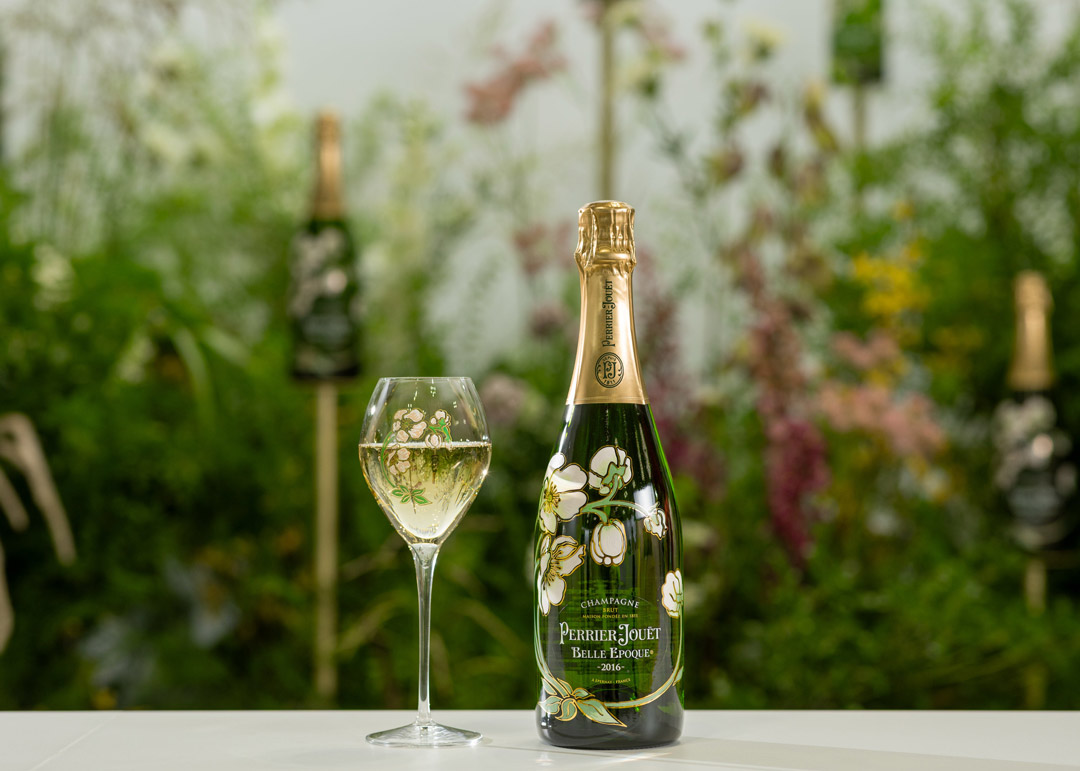
Image courtesy of Perrier-Jouët.
Veuve Clicquot
Founded in 1772, the house was shaped by Barbe Nicole Ponsardin, the widow Clicquot, who pushed quality, riddling, and export markets. The modern style is Pinot Noir-led with a firm spine and ripe orchard fruit.
Extra Brut Extra Old brings a deep well of reserve wines into focus, while La Grande Dame shows a sleeker, more chiselled character in top years. In trade terms, Yellow Label remains a global fixture and a strong brand signal.
Collectors tend to focus on La Grande Dame and mature vintages, where provenance and consistent cellaring can separate good bottles from great ones.
Cuvées
- Brut Yellow Label (NV)
- Rosé (NV)
- Extra Brut Extra Old (NV/MV)
- Rich (NV)
- Rich Rosé (NV)
- Vintage Brut (Vintage)
- Vintage Rosé (Vintage)
- La Grande Dame (Vintage)
- La Grande Dame Rosé (Vintage)
- Demi-Sec (NV)
Jacques Selosse
Anselme Selosse changed Champagne by treating vineyards with Burgundian seriousness. Low yields, barrel work, and oxidative nuance created a rich, textural style that still shows a chalk core.
The lieux-dits series maps individual parcels, while Initial and V.O. explore reserve wine building. Substance is a solera that captures a rolling house memory. Releases are small and tightly allocated.
On the market, demand far outstrips supply, which keeps prices firm. Buying is about relationships and timing rather than hunting discounts, and careful storage pays off because the wines evolve in fascinating ways over a decade or more.
Cuvées
- Initial (NV)
- Version Originale (V.O.) (NV)
- Substance (NV/MV)
- Contraste (Blanc de Noirs) (NV)
- Rosé (NV)
- Millésimé (Vintage)
- Exquise (Sec) (NV)
- Lieux-dits series (e.g., Les Carelles, etc.) (Vintage)
Egly-Ouriet
Based in Ambonnay, Egly-Ouriet is a reference for grower Champagne with Pinot Noir at the centre. Long lees ageing and barrel fermentation bring depth and a savoury frame without heaviness.
Les Crayères is a powerful old-vine blanc de noirs that shows palpable chalk. Les Vignes de Vrigny highlights Meunier with unexpected cut. The style is vinous, structured, and best with food.
Secondary market interest has risen with the broader grower wave, yet pricing still reflects the house’s quiet approach. Back vintages with long tirage can be thrilling, so provenance and disgorgement dates are worth checking.
Cuvées
- Brut Tradition Grand Cru (NV)
- V.P. Vieillissement Prolongé (NV)
- Blanc de Noirs 'Les Crayères' Vieilles Vignes (Vintage)
- Les Vignes de Vrigny 1er Cru (NV)
- Rosé Grand Cru (NV)
- Millésimé (Vintage)
Philipponnat
Aÿ-based and family-linked since the sixteenth century, Philipponnat blends a classic house range with singular sites. Clos des Goisses is one of Champagne’s most famous slopes, a steep, warm-walled vineyard that gives a muscular, precise wine built for long ageing.
The 1522 cuvées offer a step into a leaner, mineral style. Royale Réserve shows the house’s generous, Pinot-accented profile in non-vintage form. Collectors focus on Clos des Goisses and Juste Rosé, where vintage variation is real and part of the appeal.
Well-stored bottles develop truffle, smoke, and salted citrus with impressive length.
Cuvées
- Royale Réserve Brut (NV)
- Royale Réserve Rosé (NV)
- Royale Réserve Non-Dosé (NV)
- Royale Réserve Blanc de Noirs (NV)
- Réserve Millésimée (Vintage)
- Grand Blanc (Blanc de Blancs) (Vintage)
- 1522 Brut (Vintage)
- 1522 Rosé (Vintage)
- Clos des Goisses (Vintage)
- Clos des Goisses Juste Rosé (Vintage)
Ruinart
Founded in 1729 and often associated with a luminous, Chardonnay-led style, Ruinart has a clean, modern touch that still shows classical roots. Blanc de Blancs is a byword for freshness and fine mousse, while the Dom Ruinart wines step into grand cru terroir with longer ageing that brings cream, smoke, and zest.
The rosé mixes red berry lift with chalk detail. In the market, Dom Ruinart has become a quiet favourite for collectors who enjoy blanc de blancs with a serious frame. Older vintages in good condition offer value compared with some louder neighbours in the prestige set.
Cuvées
- R de Ruinart Brut (NV)
- Ruinart Rosé (NV)
- Ruinart Blanc de Blancs (NV)
- Dom Ruinart Blanc de Blancs (Vintage)
- Dom Ruinart Rosé (Vintage)
Henri Giraud
Aÿ-focused and oak-friendly, Henri Giraud works closely with Argonne forest cooperage to shape texture and spice. The range blends multi-vintage depth with site detail, while Argonne sits at the top as a rich, layered statement wine.
The house leans on Pinot Noir from Aÿ, which brings breadth and a savoury core. Dame-Jane, raised in amphora, shows a different, lifted face of rosé. Market interest has grown as the style has sharpened in recent years.
Allocations can be tight for the flagship cuvées, and mature bottles show how the oak integrates into silk with time.
Cuvées
- Esprit Nature (NV)
- Hommage à François Hémart (NV)
- Aÿ Grand Cru MV (NV/MV)
- Argonne (Vintage)
- Dame-Jane Rosé (NV)
Pierre Péters
A Le Mesnil specialist with deep roots, Pierre Péters is synonymous with pure, linear blanc de blancs. Precision farming and thoughtful use of reserve wines give the NV a clean, chalk-edged cut, while Les Chétillons, from a trio of parcels, is a benchmark for grand cru Chardonnay that ages on a steady, graceful curve.
Monsieur Victor blends top components into an editioned multi-vintage. On the market, Chétillons is keenly followed but remains more attainable than a handful of rarities. Older disgorgements develop hazelnut and pastry without losing line, which rewards patient buyers who track release notes.
Cuvées
- Cuvée de Réserve Blanc de Blancs (NV)
- Extra Brut (NV)
- L'Esprit (Vintage)
- Millésime (Vintage)
- Rosé for Albane (NV)
- Cuvée Spéciale Les Chétillons (Vintage)
- L’Étonnant Monsieur Victor (NV/MV)
Charles Heidsieck
Few houses manage the combination of depth and approachability like Charles Heidsieck. A lavish reserve wine library and long ageing deliver a plush texture that never feels heavy. Brut Réserve is a lesson in balance, while Blanc des Millénaires is a grand cru blanc de blancs released only in top years.
Rosé Réserve trades in spice and red fruit with fine poise. Collectors often target Blanc des Millénaires for cellars due to its track record and sensible pricing at release. Back vintages with correct provenance can show remarkable complexity that punches above many higher-priced peers.
Cuvées
- Brut Réserve (NV)
- Rosé Réserve (NV)
- Blanc de Blancs (NV)
- Brut Millésimé (Vintage)
- Rosé Millésimé (Vintage)
- Blanc des Millénaires (Vintage)
Piper-Heidsieck
Under refreshed leadership, Piper-Heidsieck has sharpened quality across the range. Cuvée Brut is a bright, energetic style, while Rosé Sauvage is unapologetically red-fruited and gastronomic. The Essentiel line skews drier and more detailed, with longer time on lees and informative back labels.
Vintage bottlings bring a firmer structure that suits food. In the market, value has been a key draw, particularly with Essentiel in restaurants, and recent critical attention has nudged collectors to look again at older vintage releases which can surprise with savoury complexity after a decade in bottle.
Cuvées
- Cuvée Brut (NV)
- Rosé Sauvage (NV)
- Essentiel (Extra Brut line) (NV)
- Blanc de Blancs (Essentiel range) (NV)
- Vintage Brut (Vintage)
- Vintage Rosé (Vintage)
Ulysse Collin
Olivier Collin farms and vinifies by parcel, bottling single terroirs with minimal makeup to let texture and chalk speak. Les Maillons, Les Roises, Les Enfers, and Les Pierrières each show a different face of the Côte des Blancs and the Sézannais. Barrel work and long ageing add layers without masking place.
Releases are small and highly sought after. On the market, Collin sits with the most chased growers. Pricing reflects scarcity but the wines merit the attention, evolving from electric and mineral in youth to creamy, saline, and complex over time. Disgorgement and base year details matter.
Cuvées
- Les Pierrières (Blanc de Blancs) (Vintage)
- Les Roises (Blanc de Blancs) (Vintage)
- Les Enfers (Blanc de Blancs) (Vintage)
- Les Maillons (Blanc de Noirs) (Vintage)
- Les Maillons Rosé de Saignée (Vintage)
Cédric Bouchard
Working under the Roses de Jeanne and Inflorescence labels, Cédric Bouchard bottles single parcels, single varieties, and single years. Yields are kept exceptionally low and dosage is minimal, giving wines that feel pure, silken, and intensely site-specific.
Les Ursules and Les Maillons show two faces of Pinot Noir, while Les Bolorées, a rare Pinot Blanc, is a cult oddity. Ageing brings cream and spice without losing that quiet intensity. Releases are tiny and tightly allocated.
On the market, demand is constant and pricing reflects scarcity. Disgorgement dates and base year details are well worth noting.
Cuvées
- Côte de Val Vilaine (Vintage)
- Les Ursules (Vintage)
- Les Bolorées (Pinot Blanc) (Vintage)
- La Haute-Lemblée (Vintage)
- Le Creux d’Enfer Rosé (Vintage)
Armand de Brignac
The modern luxury label made in partnership with the Cattier family is instantly recognisable for its metallic bottles and Ace of Spades insignia. Behind the gloss sits a ripe, plush house style that blends fruit from multiple vintages and a broad spread of crus.
The Blanc de Noirs and Blanc de Blancs sit at the top with richer textures and longer ageing. Rosé is deeply coloured and gastronomic. On the market, brand visibility drives demand, particularly for large formats and gift seasons.
The rarer blanc bottlings and library magnums tend to see the most collector interest over time.
Cuvées
- Gold Brut (NV)
- Rosé (NV)
- Blanc de Blancs (NV)
- Blanc de Noirs (NV)
- Demi-Sec (NV)
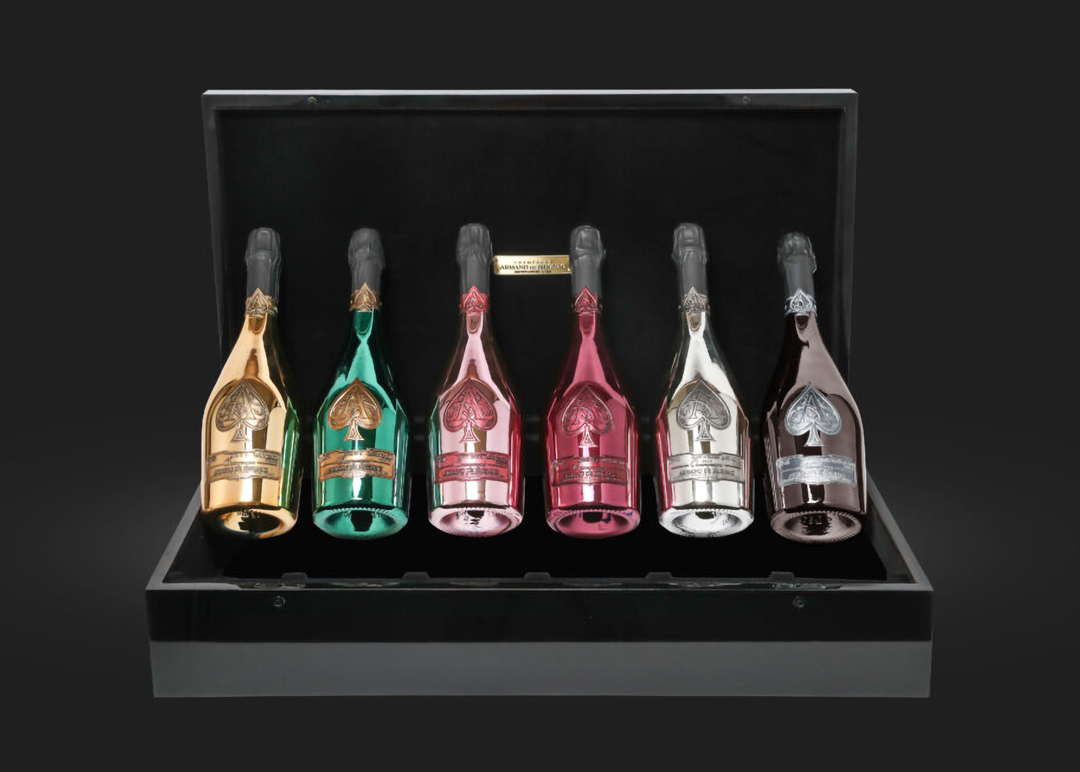
Image courtesy of Champagne Armand de Brignac.
Delamotte
Sister house to Salon and based in Le Mesnil, Delamotte offers a clear window onto Côte des Blancs Chardonnay at sensible prices. The non-vintage wines are straight and floral, with a chalk line that keeps them lively at the table.
Vintage Blanc de Blancs steps up in structure and can age very well, often surprising drinkers with honeyed depth after a decade. Delamotte benefits from Salon’s exacting vineyard sourcing and sits as a graceful everyday grand cru option.
Savvy buyers often tuck away the vintage Blanc de Blancs for drinking rather than trading, as value stays attractive.
Cuvées
- Brut (NV)
- Blanc de Blancs (NV)
- Rosé (NV)
- Vintage Blanc de Blancs (Vintage)
Laurent-Perrier
A large, focused house that has leaned into freshness and a clean, modern profile. Cuvée Rosé remains a benchmark for pure, macerated Pinot with bright red fruit. Grand Siècle blends three complementary vintages to create balance and depth beyond a single year.
Ultra Brut shows the bone-dry side, while the Blanc de Blancs Brut Nature adds a crisp, citrus cut. In the market, Grand Siècle Iterations have caught collector attention because the blend recipe and release notes give transparency and a clear ladder of quality without the volatility of tiny production prestige labels.
Cuvées
- La Cuvée Brut (NV)
- Cuvée Rosé (NV)
- Harmony (Demi-Sec) (NV)
- Ultra Brut (NV)
- Blanc de Blancs Brut Nature (NV)
- Vintage Brut (Vintage)
- Grand Siècle (Iteration) (NV/MV)
- Alexandra Rosé (Vintage)
Pascal Agrapart
Based in Avize and working largely by hand, Pascal Agrapart crafts a suite of Chardonnay-driven wines that speak clearly of chalk and low dosage. Les 7 Crus and Terroirs are textbook Côte des Blancs, while Minéral, Avizoise, and Vénus step into single-site detail with broader texture. Complantée adds field blend intrigue.
The wines are calm, precise, and age on a steady glide from citrus and salt to brioche and hazelnut. Demand has risen with grower interest, yet prices remain grounded compared with hyped names. Provenance and disgorgement information help you pick the right moment to drink.
Cuvées
- Les 7 Crus (NV)
- Terroirs (NV)
- Complantée (NV)
- Minéral (Vintage)
- Avizoise (Vintage)
- Vénus (Vintage)
- Expérience (NV/MV)
Pommery
An innovator with a long history in Reims, Pommery popularised the brut style in the nineteenth century. Today the range runs from bright, accessible Brut Royal to the refined Cuvée Louise, which is released in strong years with a long lees profile. Seasonal cuvées play with variety, while Apanage adds a gastronomic step up.
The house style is clean and citrus-led with a fine mousse. Cuvée Louise in mature vintages has a loyal following and often offers value against higher-profile peers. Older bottles with correct storage show toast, honey, and a salted almond note that pairs well with richer dishes.
Cuvées
- Brut Royal (NV)
- Royal Blue Sky (Sec) (NV)
- Apanage Brut (NV)
- Apanage Rosé (NV)
- Apanage Blanc de Blancs (NV)
- Springtime (Rosé) (NV)
- Summertime (Blanc de Blancs) (NV)
- Wintertime (Blanc de Noirs) (NV)
- Falltime (Blanc de Noirs) (NV)
- Millésimé (Vintage)
- Cuvée Louise (Vintage)
- Cuvée Louise Rosé (Vintage)
Jérôme Prévost
Working under La Closerie in Gueux, Jérôme Prévost is synonymous with Meunier grown on sand and limestone over the Montagne de Reims. Les Béguines is a single-parcel wine that ferments and ages in barrel before long lees time, giving striking texture and spice. Fac-simile, the rosé, is rare and vinous.
Quantities are exceedingly small, and allocations are thin on the ground. On the secondary market, releases are snapped up quickly, and mature bottles are prized by sommeliers for their food versatility, evolving from red apple and spice to savoury complexity with a few years of patience.
Cuvées
- La Closerie Les Béguines (Vintage)
- Fac-simile (Rosé) (Vintage)
Deutz
Founded in 1838 in Aÿ, Deutz sits slightly under the radar for consumers yet holds strong respect among professionals. The style is elegant, finely beaded, and quietly persistent. Amour de Deutz is the prestige blanc de blancs, released in top years with a long, creamy palate and chalk freshness.
The vintage wines show clear cut and age gracefully. Rosés are gastronomic rather than sweet. For collectors, Amour is the natural focus, and older vintages can still be found without the premiums seen elsewhere. Restaurant placements help liquidity and keep the house in view of informed drinkers.
Cuvées
- Brut Classic (NV)
- Rosé (NV)
- Blanc de Blancs (NV)
- Demi-Sec (NV)
- Brut Millésimé (Vintage)
- Rosé Millésimé (Vintage)
- Amour de Deutz (Blanc de Blancs) (Vintage)
- Amour de Deutz Rosé (Vintage)
Nicolas Feuillatte
A large cooperative brand with broad distribution, Nicolas Feuillatte offers a wide range that moves from fruit-driven non-vintage wines to the prestige Palmes d’Or. The latter, in both blanc de noirs and rosé, has a track record of ageing into spice, truffle, and citrus cream. Recent vintages have shown a keener mineral line.
For many buyers, this is a gateway house, widely available and dependable in style. On the market, Palmes d’Or is the collector focus and can provide mature drinking without chasing scarce grower allocations, especially when sourced from well-stored library releases.
Cuvées
- Réserve Exclusive Brut (NV)
- Réserve Exclusive Rosé (NV)
- Réserve Exclusive Blanc de Blancs (NV)
- Réserve Exclusive Brut Nature (NV)
- Grande Réserve (NV)
- Brut Millésimé (Vintage)
- Palmes d’Or (Blanc de Noirs) (Vintage)
- Palmes d’Or Rosé (Vintage)
Emmanuel Brochet
Working a single hillside at Mont Benoit near Villers-aux-Noeuds, Emmanuel Brochet farms organically and vinifies with a light touch to let the site speak. The wines show a cool herbal lift over stone fruit and citrus, with a savoury line that comes from careful élevage and patient lees ageing. Oak is present but never heavy.
Rosé has a fine red berry note and gentle grip. Releases are small and allocation-driven. On the market, demand has grown with interest in site-specific Meunier and Chardonnay blends, so back vintages with clear disgorgement info are quickly snapped up.
Cuvées
- Le Mont Benoit (Vintage)
- Le Mont Benoit Rosé (Vintage)
Lanson
Founded in 1760, Lanson is known for a fresh, non-malolactic style that keeps a lively citrus cut even with age. Black Label is a classic restaurant pour, while the Noble Cuvée range brings grand cru sourcing and longer lees ageing for cream and spice. Recent releases show a touch more polish without losing the energetic house line.
For collectors, Noble Cuvée and vintage bottlings are the focus, and older Gold Label vintages can offer mature honeyed notes at sensible prices compared with bigger-name peers, which makes them smart buys for drinking cellars.
Cuvées
- Le Black Label Brut (NV)
- Le Rosé (NV)
- Le White Label Sec (NV)
- Le Green Label Organic (NV)
- Le Black Réserve (NV)
- Blanc de Blancs (NV)
- Vintage Brut (Gold Label) (Vintage)
- Noble Cuvée Brut (Vintage)
- Noble Cuvée Blanc de Blancs (Vintage)
- Noble Cuvée Rosé (Vintage)
- Demi-Sec (NV)
Frédéric Savart
Based in Écueil, Frédéric Savart works mostly with Pinot Noir on sand and limestone, which gives sleek, aromatic wines with fine grip. L’Ouverture and L’Accomplie are benchmarks for pure, dry grower style, while single parcel bottlings like Les Noues and Le Mont des Chrétiens add detail and texture. L’Année captures a season with clarity.
Quantities are modest and releases are watched by sommeliers. Secondary pricing has risen with the wider grower wave, yet many bottles still feel fairly priced for the quality. Disgorgement and base year matter here, as the wines evolve in distinct steps over time.
Cuvées
- L’Ouverture (Pinot Noir) (NV)
- L’Accomplie (blend) (NV)
- L’Année (Vintage) (Vintage)
- Les Noues (PN) (Vintage)
- Le Mont des Chrétiens (Chardonnay) (Vintage)
- Bulles de Rosé (NV)
G.H. Mumm
One of Champagne’s most recognisable names, Mumm balances wide distribution with a push on quality at the top. The Grand Cordon line defines the modern house style, bright and fruit-forward with a clean finish. The RSRV range is the insider’s pick, a set of terroir-focused cuvées from key crus that bring more structure, detail, and ageing potential.
In the market, RSRV has opened a new conversation with collectors who had overlooked the brand, while the core wines continue to anchor by-the-glass lists worldwide, which supports steady demand across formats and vintages.
Cuvées
- Cordon Rouge Brut (NV)
- Cordon Rouge Rosé (NV)
- Grand Cordon Brut (NV)
- Grand Cordon Rosé (NV)
- Grand Cordon Blanc de Blancs (NV)
- RSRV Blanc de Blancs (Vintage)
- RSRV Blanc de Noirs (Vintage)
- RSRV 4.5 (Vintage)
- RSRV Rosé (Vintage)
- Demi-Sec (NV)
Béreche et Fils
A beacon for thoughtful farming and precise cellar work, Béreche has built a suite of wines that balance energy and texture. Brut Réserve is a reference point for non-vintage grower Champagne, while Reflet d’Antan captures a rolling memory of the cellar through perpetual reserves. Single-site wines like Le Cran and Les Beaux Regards show chalk and herb detail with fine length. The rosé is savoury and gastronomic.
Allocations are tight and pricing has climbed, but quality has kept pace. Disgorgement dates and base year details reward close attention, particularly for the more textural single-parcel wines.
Cuvées
- Brut Réserve (NV)
- Reflet d’Antan (NV/MV)
- Rive Gauche (Meunier) (Vintage)
- Rive Droite (Pinot Noir) (Vintage)
- Le Cran (Vintage)
- Les Beaux Regards (Vintage)
- Campania Remensis Rosé (Vintage)
Vilmart & Cie
Often described as the grower for people who love classically shaped Champagne, Vilmart uses oak with a deft hand to bring breadth and polish. Grand Cellier shows the lifted house style, while Coeur de Cuvée sits near the top with layered citrus, pastry, and chalk. Emotion is a serious rosé with structure and spice.
The wines age beautifully, trading primary brightness for honeyed depth after a decade. In collections, Coeur de Cuvée is the star and tends to appreciate quietly as bottles are drunk. Restaurant placement helps liquidity without pushing prices into hype territory.
Cuvées
- Grande Réserve (NV)
- Grand Cellier (NV)
- Grand Cellier d’Or (Vintage)
- Grand Cellier Rubis (Rosé) (Vintage)
- Cœur de Cuvée (Vintage)
- Emotion Rosé (Vintage)
Jacquesson
A house with deep history that behaves like a meticulous grower, Jacquesson retired its fixed non-vintage and moved to numbered 700 series cuvées, each tied to a base year and a clear recipe. Lieux-dits like Dizy Corne Bautray and Aÿ Vauzelle Terme offer chiselled, age-worthy snapshots of site. The style is dry, textural, and mineral.
Collectors enjoy the transparency, which makes verticals rewarding to taste and to own. Older 700 series disgorgements with low dosage hold their line well over time, gaining savoury complexity without losing the saline cut that defines the house.
Cuvées
- Cuvée 7xx Extra Brut (series) (NV/MV)
- Dizy Corne Bautray (Lieu-dit) (Vintage)
- Avize Champ Caïn (Lieu-dit) (Vintage)
- Aÿ Vauzelle Terme (Lieu-dit) (Vintage)
- Aÿ Terres Rouges Rosé (Lieu-dit) (Vintage)
Gosset
The oldest wine house in Champagne, founded in 1584, Gosset has a firm, gastronomic style that avoids malolactic fermentation to keep tension. Grande Réserve and Grand Rosé are precise and mouthwatering, while Celebris sits at the top with long lees time and a layered palate that marries citrus, spice, and chalk. 12 Ans de Cave gives a ready-to-drink take on extended ageing.
For investors and collectors, Celebris offers maturity and pedigree at prices that often undercut the loudest prestige labels, which makes back vintages a sweet spot for restaurant lists and patient private cellars.
Cuvées
- Grande Réserve Brut (NV)
- Grand Rosé (NV)
- Extra Brut (NV)
- Grand Blanc de Blancs (NV)
- Grand Millésime (Vintage)
- Celebris Brut (Vintage)
- Celebris Rosé (Vintage)
- 12 Ans de Cave (NV/MV)
- Petite Douceur Rosé (Sec) (NV)
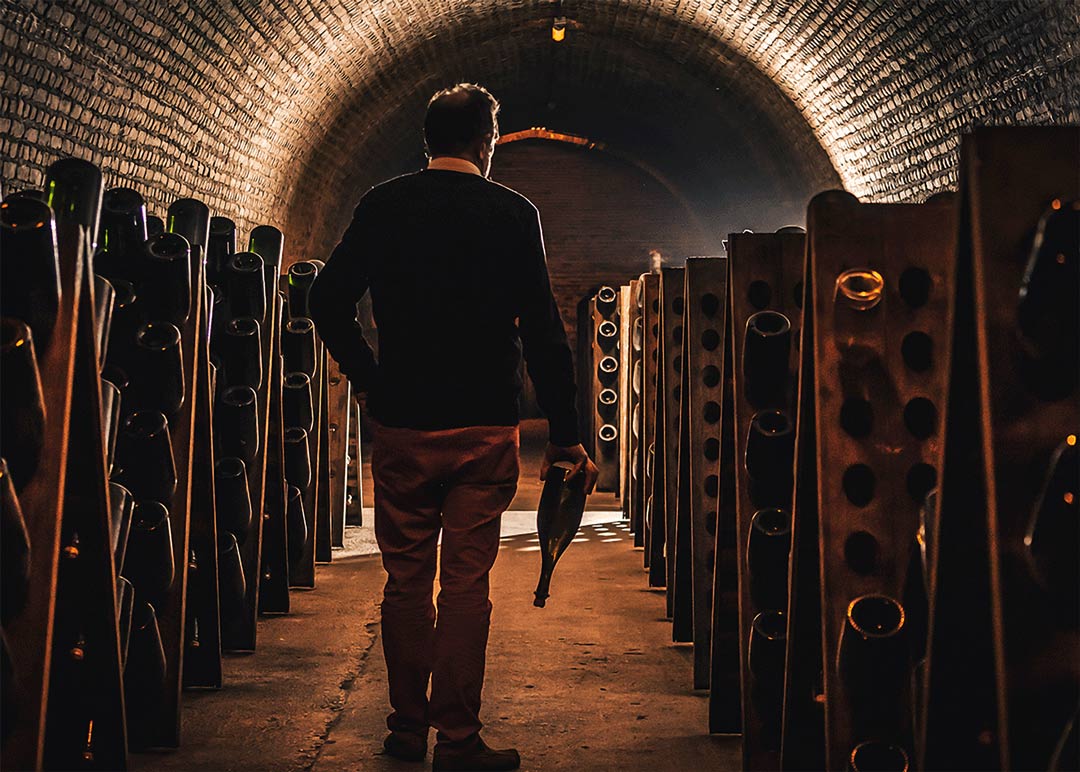
Image courtesy of Maison de Champagne Gosset.
Larmandier-Bernier
A Côte des Blancs specialist with biodynamic farming, Larmandier-Bernier focuses on pure Chardonnay expression. Latitude and Longitude introduce the style, ripe yet saline, while Terre de Vertus and single-site wines such as Vieille Vigne du Levant and Les Chemins d’Avize show deep chalk imprint and long, savoury finishes. Rosé de Saignée is serious and structured.
Demand has grown with interest in transparent, low-dosage wines. Older bottles develop pastry and hazelnut while keeping line, which attracts collectors who value drinkability over display value. Provenance and disgorgement notes are worth tracking.
Cuvées
- Latitude (NV)
- Longitude (NV)
- Terre de Vertus (non-dosé) (Vintage)
- Rosé de Saignée (NV)
- Vieille Vigne du Levant (Vintage)
- Les Chemins d’Avize (Vintage)
Ayala
Lean, clean, and focused, Ayala sits within the Bollinger family and pursues a dry, citrus-led profile. Brut Majeur is crisp and reliable, while Brut Nature shows the bone-dry side done well. The Blanc de Blancs brings grand cru detail with a fine bead and a chalky finish. Perle d’Ayala is the prestige step, released in strong years with longer ageing that adds cream and spice.
For value-minded collectors, Ayala’s vintage wines offer mature drinking without the premiums attached to bigger names, which makes them a clever addition to a balanced Champagne cellar.
Cuvées
- Brut Majeur (NV)
- Rosé Majeur (NV)
- Brut Nature (NV)
- Blanc de Blancs (Vintage)
- Vintage Brut (Vintage)
- Perle d’Ayala (Vintage)
Boërl & Kroff
A rare project from Eric Rodez and Michel Drappier that bottles grand cru Pinot Noir from Aÿ, Bouzy, and Ambonnay at a luxury level. The style is broad and layered, with long ageing and a savoury, truffled complexity that builds with time. Releases are tiny and presentation is lavish. There is also a second label, B de Boërl & Kroff, which offers a doorway into the style.
On the market, scarcity and packaging drive prices, and older magnums command strong attention. Buyers treat these as showpiece bottles, best sourced from trusted cellars with full provenance.
Cuvées
- Boërl & Kroff Brut (Vintage)
- Boërl & Kroff Rosé (Vintage)
- B de Boërl & Kroff (NV)
Dhondt-Grellet
Based in the Côte des Blancs, Adrien Dhondt crafts Chardonnay-focused wines with fine chalk imprint and low dosage. Dans un Premier Temps is an elegant house calling card, while single-parcel bottlings such as Les Terres Fines and Les Nogers give a clear view of village nuance. Oak brings gentle breadth rather than obvious spice.
The wines have gathered momentum with the grower wave and now feature on many serious lists. Collectors track disgorgement information closely. Value remains attractive next to the most chased names, making this a smart pick for those building a cellar around terroir clarity.
Cuvées
- Dans un Premier Temps (NV)
- Les Terres Fines (Cuis 1er Cru) (Vintage)
- Les Nogers (Vintage)
- Le Bateau (Vintage)
- Les Rocheforts (Vintage)
- Rosé de Saignée (Vintage)
Marie-Noëlle Ledru
A cult name from Ambonnay, Marie-Noëlle Ledru built a loyal following with pure, classically framed Pinot Noir-driven Champagnes that speak of chalk and patience. Farming is meticulous and oak use is restrained, which keeps the wines focused and savoury. Cuvée du Goulté, a blanc de noirs, is particularly sought after for its depth and ageing potential.
Production has been small in recent years, which has tightened allocations. In the market, prices reflect rarity, but bottles with clear storage history are prized by drinkers who value substance over sheen and prefer transparent, place-first wines.
Cuvées
- Grand Cru Brut (NV)
- Grand Cru Extra Brut (NV)
- Cuvée du Goulté (Blanc de Noirs) (Vintage)
- Rosé Grand Cru (NV)
Jules Brochet
Working mostly around Écueil, Jules Brochet produces a tidy range that blends Pinot Noir structure with a bright, modern touch. House brut and extra brut labels are clean and gastronomic, while single-parcel releases bring more detail and a step up in texture. The style is direct, aromatic, and easy to place at the table.
For collectors, the interest lies in the small lot site wines, which show village nuance without straying into heaviness. Prices remain fair and availability is reasonable, which makes the producer a useful source of characterful bottles for drinking cellars rather than speculation.
Cuvées
- Signature / Héritage Brut (NV)
- Extra Brut (NV)
- Single-parcel releases (various) (Vintage)
- Rosé (NV)
De Saint-Gall
The Union Champagne cooperative’s premium label draws on a vast network of Côte des Blancs vineyards, many in grand cru villages. The house style is sleek and citrus-led, with a fine bead and chalky finish. Orpale sits at the top as a vintage blanc de blancs with long lees ageing and a creamy, mineral palate that ages gracefully. Non-vintage bottlings are reliable and good value.
On the market, Orpale is the collector focus and often flies under the radar, giving access to mature blanc de blancs at prices below the glossier prestige names.
Cuvées
- Brut Réserve / Sélection (NV)
- Premier Cru Brut (NV)
- Blanc de Blancs (NV)
- Rosé (NV)
- Orpale Blanc de Blancs (Vintage)
- Vintage Brut (Vintage)
Drappier
Family-run in the Aube, Drappier champions Pinot Noir and a low-intervention approach, with minimal sulphur and a preference for natural freshness. Carte d’Or is generous and fruit-forward, while Brut Nature Pinot Noir shows the bone-dry side with fine grip. Grande Sendrée is the flagship, a richer, age-worthy wine that rewards patience in both blanc and rosé forms. The quirky Quattuor blends four white grapes, and Clarevallis leans into organic farming.
For investors and collectors, Grande Sendrée and well-stored older vintages offer mature complexity without heavy premiums. Large formats are strong picks.
Cuvées
- Carte d’Or Brut (NV)
- Carte d’Or Demi-Sec (NV)
- Brut Nature Pinot Noir Zero Dosage (NV)
- Rosé de Saignée Brut (NV)
- Blanc de Blancs (NV)
- Millésime Exception (Vintage)
- Grande Sendrée (Vintage)
- Grande Sendrée Rosé (Vintage)
- Quattuor (Blanc de Quatre Blancs) (NV)
- Clarevallis (NV)
- Cuvée Charles de Gaulle (NV)
Chartogne-Taillet
Alexandre Chartogne’s wines from Merfy are a lesson in how sand and chalk can give texture and lift. Sainte-Anne balances approachability and detail, while single-parcel bottlings like Les Barres, Les Orizeaux, and Heurtebise show distinct personalities. Farming is thoughtful and cellar work measured, which keeps freshness and depth.
These are wines that improve over a few years in bottle and sing at the table. Market interest has grown steadily, yet pricing remains sane next to the hottest growers, which keeps Chartogne-Taillet a favourite for sommeliers building broad, educational by-the-glass programmes.
Cuvées
- Sainte-Anne (NV)
- Les Barres (Vintage)
- Les Orizeaux (Vintage)
- Les Longues Voyes (Vintage)
- Heurtebise (Vintage)
- Chemin de Reims (Vintage)
- Rosé (NV)
Marguet
Benoît Marguet farms biodynamically in Ambonnay and Bouzy, shaping intensely site-driven wines with zero or incredibly low dosage. Shaman is the calling card, bright and pure, while the grand cru single parcels show serious structure and minerality. Sapience, made with friends, is one of Champagne’s first fully biodynamic prestige projects. The style is vivid and gastronomic, with a savoury thread that suits the table.
Collectors prize the single-parcel bottlings and limited editions, though prices still feel grounded when compared with the most hyped names. Disgorgement info helps chart each wine’s ideal drinking window.
Cuvées
- Shaman (NV)
- Shaman Rosé (NV)
- Yuman (NV)
- Sapience (NV/MV)
- Grand Cru Single-Parcels (e.g., Les Crayères, Le Parc, La Grande Ruelle) (Vintage)
Pierre Paillard
Run by the Paillard family in Bouzy, this estate focuses on precision and clarity with Pinot Noir at the core. Les Parcelles is a benchmark Bouzy Grand Cru brut, while Ma Première brings a fine, dry house style. Single-parcel wines like Les Maillerettes and Les Mottelettes give focused views of Pinot Noir and Chardonnay from chalk-rich sites. La Grande Récolte offers a vintage step up with extra structure.
The range is honest and well-priced, which makes it a go-to for drinkers who want grand cru character without paying trophy premiums.
Cuvées
- Les Parcelles Bouzy Grand Cru (Brut) (NV)
- Ma Première / L’Assemblage (NV)
- Rosé Grand Cru (NV)
- Les Maillerettes (Blanc de Noirs) (Vintage)
- Les Mottelettes (Blanc de Blancs) (Vintage)
- La Grande Récolte (Vintage)
De Venoge
Founded in 1837, De Venoge is best known for its elegant Princes bottles and the prestige Louis XV cuvées. The house style is polished and citrus-led, with fine mousse and a touch of pastry from patient lees ageing. Bottlings for Princes blanc are gastronomic and well-drawn, while Louis XV is released only in strong years and has a graceful, long finish that rewards cellaring.
Secondary market interest centres on Louis XV and older vintages in smart condition. For festive seasons, the distinctive presentation helps demand across formats, especially magnums.
Cuvées
- Cordon Bleu Brut (NV)
- Cordon Bleu Rosé (NV)
- Cordon Bleu Demi-Sec (NV)
- Brut Millésimé (Vintage)
- Princes Blanc de Blancs (NV)
- Princes Blanc de Noirs (NV)
- Princes Rosé (NV)
- Louis XV (Vintage)
- Louis XV Rosé (Vintage)
